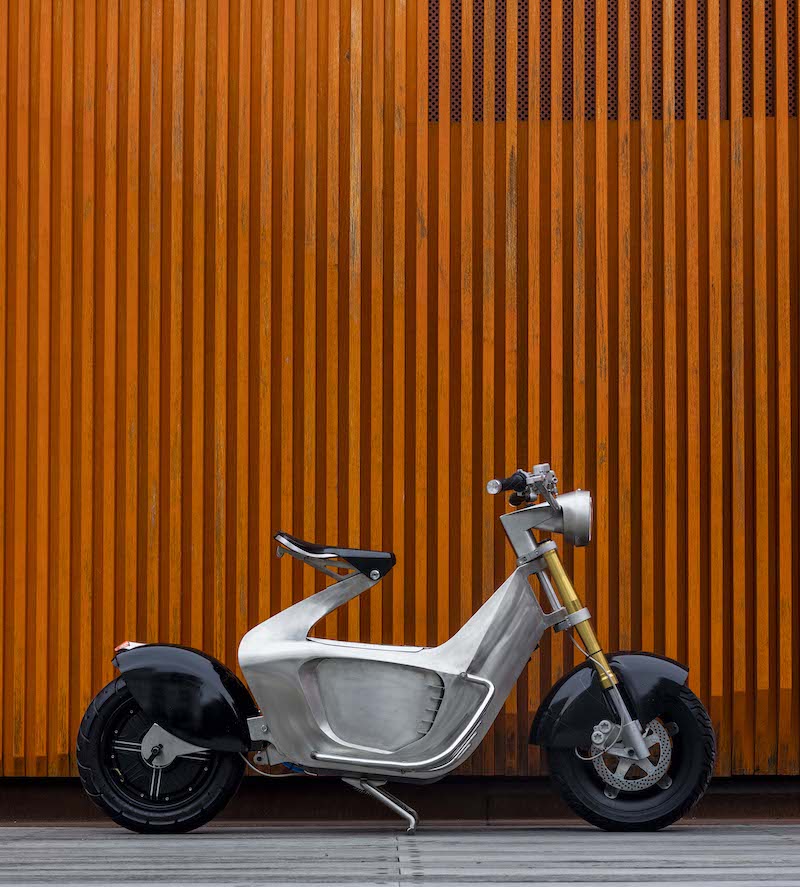
Startup uses ‘industrial origami’ technique to build electric motorbikes
Swedish technology and design startup STILRIDE is to produce sustainable electric motorcycles and scooters using a groundbreaking manufacturing process dubbed “industrial origami”.
The trailblazing technique involves robots which are able to fold single sheets of recyclable steel into intricate, lightweight and durable new structures – significantly reducing the environmental impact of production.
This process is being used to create the chassis for a fleet of next-generation e-motorcycles which will be made available to consumers in Europe later this year.
STILRIDE’s pioneering industrial origami technology, called STILFOLD, is the brainchild of best friends Tue Beijer and Jonas Nyvang, whose backgrounds span the worlds of fashion, industrial design and engineering.
With STILRIDE, the duo aim to reimagine how high-performance electric-mobility products are manufactured and distributed using cutting-edge steelwork, advanced robotics and ambitious design.
The first product STILRIDE is bringing to the mass market is the futuristic Sport Utility Scooter One (SUS1).
Unlike traditional scooters (which consist of a tubular frame and plastic body), the SUS1 is constructed by folding sheets of stainless steel over curves, much like origami.
Not only does this result in a durable body and distinctive aesthetic, but it also requires fewer raw materials and reduces labour costs.
Compared to a traditional scooter, the SUS1 requires 70 percent fewer components, drives a 25 percent reduction in labour costs and a 20 percent reduction in material costs.
It will be able to reach top speeds of 100+ km/h and will be able to travel approximately 120 km on one charge.
E-motorcycles are the first application of STILRIDE’s proprietary STILFOLD technology. Next, STILRIDE will use this technique to add cargo bikes and trailers to its product offering.
To reduce the product’s carbon footprint, the company is aiming to create a production process which allows the steel sheets to be flat-packed and shipped to local factories across Europe where they’ll be folded and fitted with a hub motor and battery pack.
Already, the climate impact of developing the SUS1’s chassis is 50 percent lower than that of traditional scooters.
There are already 90,000 people on the waiting list for the STILRIDE SUS1 e-scooter, with the first pre-series set to be released to customers in the autumn of 2022.
Jonas Nyvang, co-founder and Chief Executive Officer of STILRIDE, says: “STILRIDE sits at the intersection of technology, mobility and design.
“My co-founder Tue first introduced the idea for the scooter to me at a dinner in 2019. He sketched out how it could be manufactured using origami folding and built a model out of paper.
“It’s surreal to have now created a high-spec electric motorcycle that’s true to that original vision. It meets our commitment to sustainability whilst also having a radical and distinctive design identity.
“Not only is it unisex, but it’s uni-age. It’s designed for everyone and we hope it can be an accessible entrypoint to the world of scooters and motorcycles for those with an eye for style and a love of nature.
“The STILFOLD technology is best described as a dance between robots and steel. We have created a process which builds high-performance, sustainable personal mobility products that are also durable, lightweight and desirable.
“The SUS1 is the first application of the technology and the ambition is to apply it to cargo bikes and trailer products.
“Using STILFOLD, manufacturers can minimize resource consumption and waste, cut down on labor costs and ultimately reduce the environmental impact of production.
“We’re launching in Europe first as it’s a market that relies heavily on outsourcing and has much to gain from increasing its domestic manufacturing capabilities.
“Next, we will look to expand into other international markets. It’s an exciting time to be in the green mobility space and we’re ready to make our mark.”
